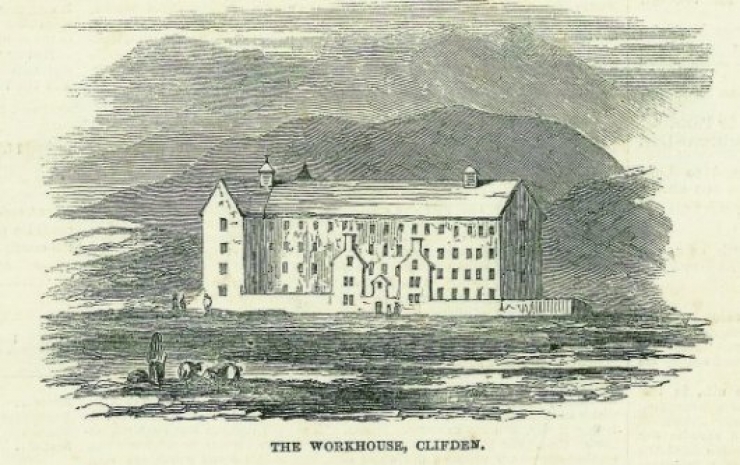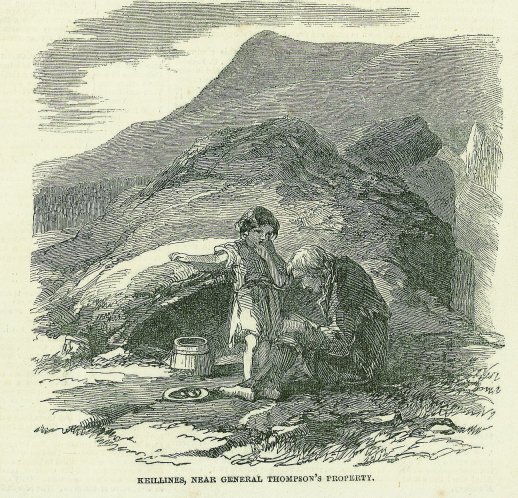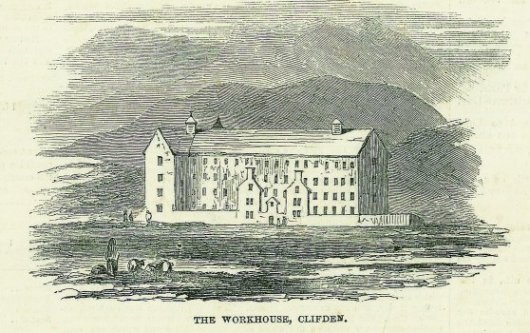 The following is an excerpt from the Illustrated London News, which was the world’s first fully illustrated newspaper, founded in 1842. In the issue of January 5th 1850, the following piece ‘Condition of Ireland, Illustrations of the New Poor Law’ was printed, detailing the journey of the writer through the famine ravaged counties of Clare and Galway.
The following is an excerpt from the Illustrated London News, which was the world’s first fully illustrated newspaper, founded in 1842. In the issue of January 5th 1850, the following piece ‘Condition of Ireland, Illustrations of the New Poor Law’ was printed, detailing the journey of the writer through the famine ravaged counties of Clare and Galway.
“I crossed the Bay to Galway, and proceeded towards Clifden by a route devoid of interest, exhibiting, in a less degree than in Clare, the usual signs of devastation in progress. Mr. Martin’s property extends almost the whole way from Ouchterade [Oughterard] to Clifden, and is a mixture of mountain, moor, and fertile land, capable of indefinite improvement, with great facility of water carriage, but most sadly neglected. It is a bad sign for the next harvest, and for the people of this country, that in my whole journey from Galway I did not see more than from thirty to forty persons, including all ages and sexes; and, with the exception of ten men working under a road contractor, few or none of them were at work.
At Carihaken, the levellers have been at work, and tumbled down eighteen houses. In one of them dwelt John Killian, who stood by me while I made the accompanying Sketch of the remains of his dwelling. He told me that he and his father’s before him had owned this now ruined cabin for ages, and that he had paid £4 a year for four acres of ground. He owed no rent: before it was due, the landlord’s drivers cut down his crops, carried them off, gave him no account of the proceeds, and then tumbled his house. The hut made against the end wall of a former habitation was not likely to remain, as a decree had gone forth entirely to clear the place. The old man also told me that his son having cut down, on the spot that was once his own garden, a few sticks to make him a shelter, was taken up, prosecuted, and sentenced to two months’ confinement, for destroying trees and making waste of the property.
I must supply you with another Sketch of a similar subject on the road between Maam and Clifden, in Joyce’s County, once famous for the Patagonian stature of the inhabitants, who are now starved down to ordinary dimensions. High up on the mountain, but on the road-side, stands the scalpeen of Keillines. It is near General Thompson’s property. Conceive five human beings living in such a hole: the father was out, at work; the mother was getting fuel on the hills, and the children left in the hut could only say they were hungry. Their appearance confirmed their words – want was deeply engraved in their faces, and their lank bodies were almost unprotected by clothing.
At Kylemore my companion bought a turbot, weighing from 18lb. to 20lb., for 1s. 6d., and might have had it for 1s. had he driven a hard bargain. The fact indicates that the sea would supply plenty of food if man would take the trouble to procure it. A similar proof of the equal capacity of the soil is found at a short distance from Kylemore. Two enterprising Englishmen, of the name of Eastwood, planted themselves there about four years ago, and all around them the bleak and barren moor has been changed into well laid-out fields – some green with herbage, and others brown and dingy with the stubble of the carried corn. There is a comfortable lodge, in the Elizabethan style, and around it suitable farm buildings. The whole indicates skill, industry, and good taste; it indicates, too, great courage in overcoming a moral as well as a physical opposition. The Messrs. Eastwood have, in some measure, conquered the habits of the people, which was a more difficult task than subduing the neglected and deserted heath. They will be pioneers to others, who will select, let us hope, this fertile and promising wilderness for the scene of their exertions, instead of wrestling against the arid sands of Australasia, or engaging in competition for the plains of the Mississippi with emigrants from all the countries of Europe. Their example has in fact been followed; and between their abode and Clifden two or three beginnings have been made – so that the country adjoining that town exhibits several signs of improvement.
This neighbourhood, before the potato rot came, was not so entirely occupied by the cultivation of the root as some other parts of the country. In the Union of Kilrush, for example, in 1848, there were 11,569 acres under potatoes, out of an area of 178,935 acres; in the Union of Clifden there were only 3714 acres, out of an area of 189,504 acres, under potatoes. The fact is of some importance, in explaining the comparative ease with which the poor in Clifden have been disposed of. Clifden itself is an exotic in an unfavourable climate. It was reared by the patronage of the late Viscount; and since that ceased, it began to decline: the Poor-law has almost finished it. Before we reached, we learned that the guardians of the union were out of money, and obliged to pay for what they wanted by cheques, which they are to receive in payment of the rates. Extreme poverty exists in the neighbourhood – the soil around is poor – great numbers of houses have been levelled – but the poor, unlike those of Kilrush, have in great part disappeared with the houses. They have not found refuge in the workhouse – they have not been carried away as emigrants; they have either wandered away or have died, or both may have contributed to cause their disappearance. I have a list of 111 houses levelled within a few months in the immediate neighbourhood of Clifden, which is very considerable, considering that the whole population of the Union was only 33,465 in 1841. Assuming five inmates to a house, the sixtieth part of the population has been dispossessed. Here, too, there is little more than one person to every six acres; or, scanty as is the population of Clare, the population of the Union of Clifden is not, in relation to acres, half so abundant. I have taken a Sketch of the workhouse, which I send as a memorial of this pet place of the late Viscount Clifden.
[Correction printed in the article of Jan. 19, 1850]
P.S. – I must correct a mistake committed in my last communication. There are two Clifdens in Ireland, and the one in Galway was the property of the D’Arcy family, and not of the Clifden family, as I stated. I am also informed that the Messrs. Eastwood are not English, but Irish-English.
From Clifden to Ouchterade [Oughterard], twenty-one miles, is a dreary drive over a moor, unrelieved except by a glimpse of Mr. Martin’s house at Ballynahinch, and of the residence of Dean Mahon. Destitute as this tract is of inhabitants, about Ouchterade some thirty houses have been recently demolished. A gentleman who witnessed the scene told me nothing could exceed the heartlessness of the levellers, if it were not the patient submission of the sufferers. They wept, indeed; and the children screamed with agony at seeing their homes destroyed and their parents in tears; but the latter allowed themselves unresistingly to be deprived of what is to most people the dearest thing on earth next to their lives – their only home.
I returned to Galway, where the Poor-law officials are not communicative, nor is there in the Union any extraordinary fact to communicate. The old town is a jumble of thatched mud cabins, stone-built houses, and the remains of a former splendour, old sculptures and carvings, putting to shame the homely and even rude houses of a modern date. The people are remarkable for the vivid colours of their dresses, amongst which red predominates, and some lingering traces of a foreign origin may yet be discovered in their countenances. Here, as in most other sea-ports and fishing towns, particularly of Ireland, hulking men lounging about were numerous, and appeared to have every other capacity to work but the will. You are not annoyed, however, by mendicants in Galway, as in other Irish towns, though there is a universal complaint of distress finished by the exclamation, “That last five-shilling rate is a death-blow to all”.
From Galway I proceeded to Ennis, and in the neighbourhood inspected the village of Clear [Clare, later Clarecastle], which had been destroyed within a few weeks, and some part of it within a few days. The Sketch of Pat Macnamara’s Cabin shows the condition of the village. In Ennis I went through the lanes and alleys, and amongst the most distressed part of the population. In one small room, not 20 feet square, I found congregated fifteen people, young and old, exhibiting nearly all the phases of want and squalor. From the smoke which filled the place, it was a Rembrandt scene, and it was with difficulty I could make out the forms of the wretched groups, or of the squalid and dying child on the floor. In the union workhouse of Ennis there is order, decency, and regularity. With it is conjoined a farm of eighteen acres, which is well cultivated by the labour of the paupers. It is wisely placed under the superintendence of one of Lord Clarendon’s practical agricultural instructors; and probably he is as well employed in displaying his skill at the farm as in any other mode of teaching his art.
At Ennis, I consider my tour terminated; and I shall only send you further some general observations on the Poor-law, and some suggestions as to what might reasonably be done for Ireland.”
The full Illustrated London News article can be seen at http://www.clarelibrary.ie/eolas/coclare/history/condition_of_ireland/condition_of_ireland_iln_jan5_1850.htm
Article reproduced here courtesy of Clare County Library.







Noted this in researching and trying to find my Heagney background in Ireland …
It is pathetic – and unbelievable and horrendous that Christians could treat others in that manner. Researching my Gannon history, I’ve learned more than I would have liked to learn about the treatment of the Irish by England … not someplace I would ever want to spend any time. Praise God for the saving of those who did survive!